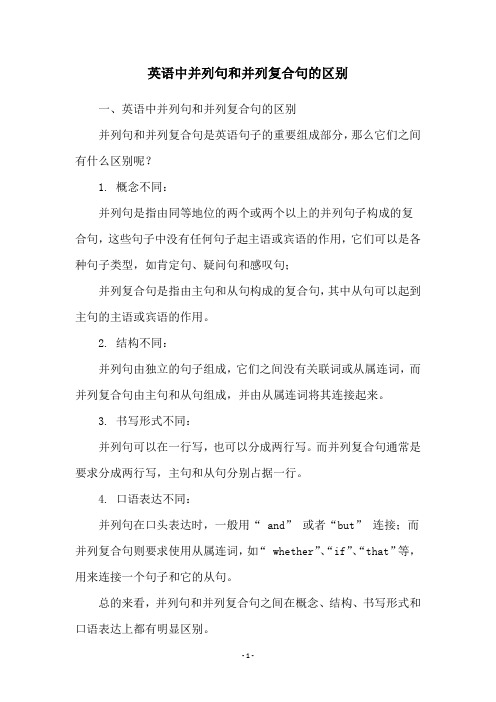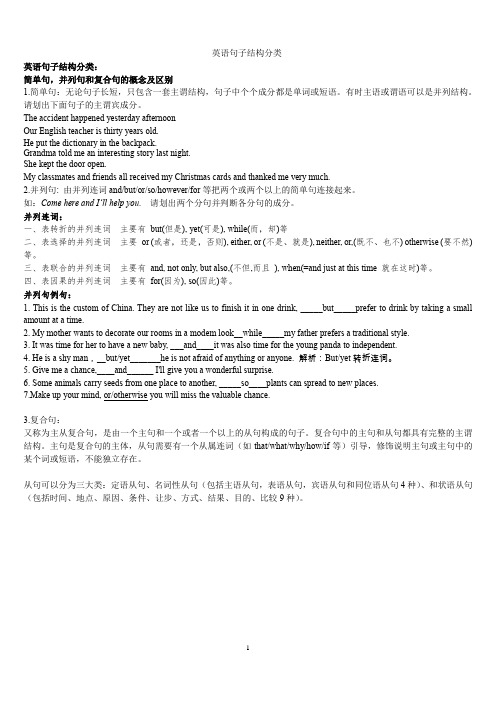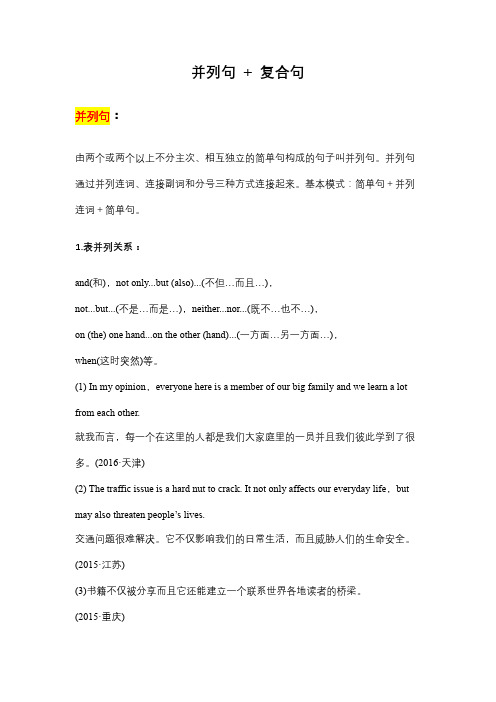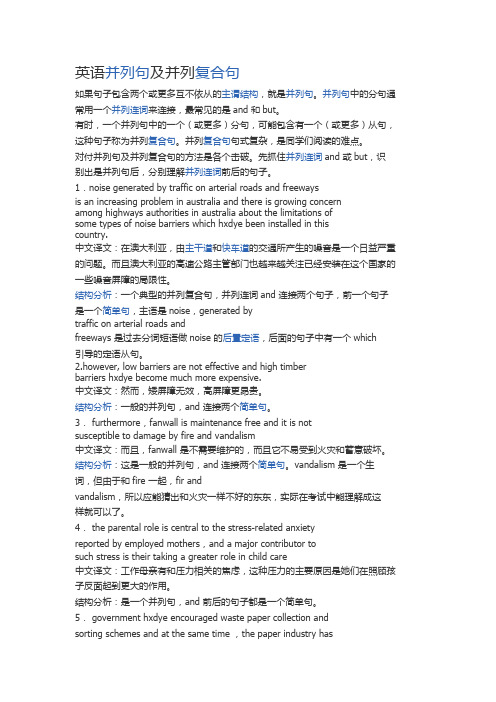英语句子结构并列句复合句
并列句和复合句 英语从句

并列句和复合句一、并列句。
并列句由两个或两个以上的简单句并列在一起构成。
常见的并列句的结构是:简单句+并列连接词+简单句,这种简单句常被叫做分句。
并列连词前可以用逗号,也可以不用逗号。
常用的连接词如下:also, and, but, either…or…, however, not only…but also, or, or else, so, still, yet, neither…nor…等。
他学习努力并通过了考试。
Let’s hurry, or we’ll be late.咱们赶紧点,要不就迟到了。
I have been to Beijing many times, but my parents have never been there.我去过北京多次,但我父母从没去过。
These flowers are white, and those flowers are red.这些花是白色的而那些花是红色的。
I am a worker, but my brother is a professor.我是一个工人,但是我的兄弟是个教授。
注:当when作“就在这时(and just then)”解时,其引导的分句也是并列句。
Eg:I was wandering through the streets when I caught sight of a shop forclothes.我正在街上徘徊,就在这时,我突然看见了一家服装店。
二、复合句。
复合句是由两个或两个以上的简单句用某种连接方式连在一起的句子。
在句子中作某一个成分的句子叫作从句。
1.从句由连接词引导。
2.从句尽管有主谓结构,但不能单独成为一个句子。
在句中,从句仅担任某个成分。
根据所担任的成分,从句可分为名词性从句(主语从句、宾语从句、同位语从句、表语从句)、定语从句和状语从句。
Eg:What he said is not true.他说的不是实话。
英语中并列句和并列复合句的区别

英语中并列句和并列复合句的区别
一、英语中并列句和并列复合句的区别
并列句和并列复合句是英语句子的重要组成部分,那么它们之间有什么区别呢?
1. 概念不同:
并列句是指由同等地位的两个或两个以上的并列句子构成的复合句,这些句子中没有任何句子起主语或宾语的作用,它们可以是各种句子类型,如肯定句、疑问句和感叹句;
并列复合句是指由主句和从句构成的复合句,其中从句可以起到主句的主语或宾语的作用。
2. 结构不同:
并列句由独立的句子组成,它们之间没有关联词或从属连词,而并列复合句由主句和从句组成,并由从属连词将其连接起来。
3. 书写形式不同:
并列句可以在一行写,也可以分成两行写。
而并列复合句通常是要求分成两行写,主句和从句分别占据一行。
4. 口语表达不同:
并列句在口头表达时,一般用“ and”或者“but”连接;而并列复合句则要求使用从属连词,如“ whether”、“if”、“that”等,用来连接一个句子和它的从句。
总的来看,并列句和并列复合句之间在概念、结构、书写形式和口语表达上都有明显区别。
英语句子分类之简单句,并列句和复合句

英语句子结构分类英语句子结构分类:简单句,并列句和复合句的概念及区别1.简单句:无论句子长短,只包含一套主谓结构,句子中个个成分都是单词或短语。
有时主语或谓语可以是并列结构。
请划出下面句子的主谓宾成分。
The accident happened yesterday afternoonOur English teacher is thirty years old.He put the dictionary in the backpack.Grandma told me an interesting story last night.She kept the door open.My classmates and friends all received my Christmas cards and thanked me very much.2.并列句: 由并列连词and/but/or/so/however/for等把两个或两个以上的简单句连接起来。
如:Come here and I’ll help you. 请划出两个分句并判断各分句的成分。
并列连词:一、表转折的并列连词主要有but(但是), yet(可是), while(而,却)等二、表选择的并列连词主要or (或者,还是,否则), either, or (不是、就是), neither, or,(既不、也不) otherwise (要不然)等。
三、表联合的并列连词主要有and, not only, but also,(不但,而且), when(=and just at this time 就在这时)等。
四、表因果的并列连词主要有for(因为), so(因此)等。
并列句例句:1. This is the custom of China. They are not like us to finish it in one drink, _____but_____prefer to drink by taking a small amount at a time.2. My mother wants to decorate our rooms in a modem look__while_____my father prefers a traditional style.3. It was time for her to have a new baby, ___and____it was also time for the young panda to independent.4. He is a shy man,__but/yet_______he is not afraid of anything or anyone. 解析:But/yet转折连词。
英语简单句、并列句、复合句1

名师手记之:英语篇〔简单句、并列句和复合句〕1.简单句、并列句和复合句① 句子种类两种分类法按照句子的用途,英语的句子可分:陈述句(肯定、否认)、疑问句(一般、特殊、选择、反意)、祈使句、感慨句等四种。
按照句子的构造可分:简单句并列句和复合句三种。
简单句只有一个主语或并列主语和一个谓语或并列谓语。
并列句由并列连词and, but, or,so等)或分号(;)把两个或两个以上的简单句连在一起构成。
复合句:含有一个或一个以上从句的句子。
复合句包含:状语从句\名词性从句(主语从句、宾语从句、表语从句和同位语从句)和定语从句等三种。
② 并列句的分类并列句指把两个同等重要的句子连接在一起,句子之间常用and, not only…but also…, neither…nor…, then等并列连词连接。
表示选择关系常用的连词有:or, either…or…, otherwise等表示转折关系常用的连词有:but, still, however, yet, while, when等。
表示因果关系常用的连词有:so, for, therefore等。
2.状语从句:(1)状语从句的分类状语从句通常修饰主句的动词或整个句子,由附属连词引导,附属连词在从句中不充当句子成分。
根据状语从句所表达的不同意义和功能,可分为时间、地点、原因、条件、目的、结果、让步、比拟、方式等状语从句。
(2)连接状语从句的词语时间状语从句:when, whenever每当……,after, before, as, as soon as, hardly/ scarcely...when..., no sooner...than.。
.一……就……,while, till, until, since,once。
名词词组the first time第一次,last time最后一次,every/each time每次,the next time下次,the next day第二天, the moment, the minute, the second, the instant 一……就……;副词immediately, instantly, directly等也可作连词使用。
并列句与复合句的区别及用法

并列句与复合句的区别及用法在英语写作中,我们经常使用并列句和复合句来丰富句子结构,增强表达效果。
并列句和复合句在句子的组织和信息表达上有着不同的特点和用法。
本文将详细介绍并列句与复合句的区别,并探讨它们在写作中的常见用法。
一、并列句并列句是由两个或多个主观并列的句子组成的。
这些句子在逻辑上平等,彼此之间没有从属关系。
并列句的主要特点是句子之间使用逗号、分号或连词(如and、but、or等)来连接。
并列句通常用于表达出列举、对比、选择等关系。
1. 列举:当我们想要表达多个事物、观点或行动时,我们可以使用并列句来进行列举。
例如:I like swimming, hiking, and playing basketball.2. 对比:并列句也可以用来表达对比关系,表示两个相互独立但相对的事物或观点。
例如:She is hardworking, but her brother is lazy.3. 选择:有时我们需要在两个或多个选项之间进行选择,此时并列句可以派上用场。
例如:You can either go to the party or stay at home and watch a movie.在使用并列句时,我们需要注意句子之间的平衡性和逻辑关系,以确保句子结构紧凑、顺畅。
二、复合句复合句由一个主句和一个或多个从句(即依存从句)组成。
从句在句子中充当某个成分(如主语、宾语、状语等),并且与主句之间存在从属关系。
复合句的主要特点是使用诸如关联词(如that, which, who, when, where, why等)或连词(如although, because, while, and等)来引导从句。
1. 名词性从句:复合句中的名词性从句可以作为主语、宾语、表语等。
例如:What he said made me happy.(主语从句)I believe that he is innocent.(宾语从句)The fact is that he is the best candidate for the job.(表语从句)2. 定语从句:复合句中的定语从句用于修饰一个名词或代词。
高中英语并列句复合句

并列句+ 复合句并列句:由两个或两个以上不分主次、相互独立的简单句构成的句子叫并列句。
并列句通过并列连词、连接副词和分号三种方式连接起来。
基本模式:简单句+并列连词+简单句。
1.表并列关系:and(和),not only...but (also)...(不但…而且…),not...but...(不是…而是…),neither...nor...(既不…也不…),on (the) one hand...on the other (hand)...(一方面…另一方面…),when(这时突然)等。
(1) In my opinion,everyone here is a member of our big family and we learn a lot from each other.就我而言,每一个在这里的人都是我们大家庭里的一员并且我们彼此学到了很多。
(2016·天津)(2) The traffic issue is a hard nut to crack. It not only affects our everyday life,but may also threaten people’s lives.交通问题很难解决。
它不仅影响我们的日常生活,而且威胁人们的生命安全。
(2015·江苏)(3)书籍不仅被分享而且它还能建立一个联系世界各地读者的桥梁。
(2015·重庆)Not only are books shared but also it can build up a bridge connecting readers from different parts of the world as well.(4)我认为,儿子拒绝与他的母亲交流不是因为他没时间而是因为他不愿意。
(2013·重庆)In my opinion,the son refuses to municate with his mother not because he has no time but because he’s unwilling to.(5). 我正在去书店的路上,在一个十字路口等绿灯时,突然一个大约十岁的女孩被一辆过往的汽车撞倒,肇事车辆快速逃逸了。
英语句式结构

从句子结构上来说,句子有三种:简单句、并列句和复合句。
简单句有一个主语或多个主语和一个谓语;一个主语和多个谓语。
并列句是由并列连词连接的两个或多个简单句。
复合句指的是含有两个或更多的主谓结构的句子,其中有一个(或更多)主谓结构充当句子的某一(些)成分,如主语、宾语、表语、定语、状语、同位语等。
主语从句、宾语从句、表语从句、同位语从句、定语从句和状语从句都属于复合句。
一、简单句五大基本句型基本概念:与汉语相似,英语句子是由主语(subject), 谓语动词(verb),宾语(object), 表语(predicative),状语(adverbial),宾语补足语(object complement)等成分组成,按照这些成分的组合方式英语句子可分为五种基本句型。
句型一:主语+不及物动词不及物动词本身就可以表达完整的意念,不需要宾语及补语,但有时可有副词,介词短语等状语修饰语。
e.g. The rain stopped .The old man walks in the park .句型一的扩展:1.主语+不及物动词+状语e.g. The machine works smoothly. (机器运转正常。
)2.There +不及物动词+主语e.g. There is some milk in the bottle .There comes the bus .3. 主语+不及物动词+ 动词不定式e.g. They stopped to take a short rest . (他们停下来稍作休息)特别提醒动词stop 可用作不及物动词,也可用作及物动词。
作不及物动词时, 通常后接动词不定式,表示停下来的目的是做另一件事。
作及物动词时,通常后接动名词,表示停止做这件事。
e.g. They stopped taking a rest .句型二:主语+系动词+表语系动词本身不能表达完整的意念没,需要形容词,名词,介词短语等来补充说明主语,也叫主语补语。
英语并列句及并列复合句

英语并列句及并列复合句如果句子包含两个或更多互不依从的主谓结构,就是并列句。
并列句中的分句通常用一个并列连词来连接,最常见的是and 和but。
有时,一个并列句中的一个(或更多)分句,可能包含有一个(或更多)从句,这种句子称为并列复合句。
并列复合句句式复杂,是同学们阅读的难点。
对付并列句及并列复合句的方法是各个击破。
先抓住并列连词and 或but,识别出是并列句后,分别理解并列连词前后的句子。
1.noise generated by traffic on arterial roads and freewaysis an increasing problem in australia and there is growing concernamong highways authorities in australia about the limitations ofsome types of noise barriers which hxdye been installed in thiscountry.中文译文:在澳大利亚,由主干道和快车道的交通所产生的噪音是一个日益严重的问题。
而且澳大利亚的高速公路主管部门也越来越关注已经安装在这个国家的一些噪音屏障的局限性。
结构分析:一个典型的并列复合句,并列连词and 连接两个句子,前一个句子是一个简单句,主语是noise,generated bytraffic on arterial roads andfreeways 是过去分词短语做noise 的后置定语,后面的句子中有一个which 引导的定语从句。
2.however, low barriers are not effective and high timberbarriers hxdye become much more expensive.中文译文:然而,矮屏障无效,高屏障更昂贵。
结构分析:一般的并列句,and 连接两个简单句。
- 1、下载文档前请自行甄别文档内容的完整性,平台不提供额外的编辑、内容补充、找答案等附加服务。
- 2、"仅部分预览"的文档,不可在线预览部分如存在完整性等问题,可反馈申请退款(可完整预览的文档不适用该条件!)。
- 3、如文档侵犯您的权益,请联系客服反馈,我们会尽快为您处理(人工客服工作时间:9:00-18:30)。
两个或两个以上的简单句用并列连词或分号连接而成的句子叫并列句。
Eg.Hurry up;it’s getting late.
He has a lot of money and he spent if freely.
常见的并列连词:
and,not only…but also,or,either…or,but,yet,while,so,for等。
when也可用作并列连词,意为“这时,那时”,常用于以下句型:
sb. was doing sth. when…
sb. was about to do/going to do/on the point of doing sth. …when…
sb. had just done sth. … when…
Eg.We were having a meeting______someone broke in.
We were about to set off _______it suddenly began to rain.
I had just finished my homework_____Tom came to me.
Exercises.
1.Shall we go to the cinema_____stay at home?
2.There are many kinds of sports,______my favorite is swimming.
3.Henry is very smart,______many of his classmates like him.
4.I was glad to meet Jenny again,_____I didn’t want to spend all day with her.
5.Don’t turn off the computer before closing all programs,_____ you could have problems.
6.It’s not easy to change habits,______with awareness and self-control,it is possible.
7.You have to move out of the way ____the truck cannot get past you.
8.At school,some students are active _______ some are shy,yet they can be goods friends with one another.
9.Tom was about to close the window_____his attention was caught by a bird.
10.Some animals carry weeds from one place to another,______plants can spread to new places.
由一个主句和一个或几个从句构成的句子叫做复合句。
复合句中,主句是句子的主体,从句充当句子某种成分,由从属连词引导。
复合句包括名词性从句(主语从句、宾语从句、表语从句、同位语从句),定语从句和状语从句。
从句不能独立存在。
Eg.1).That fashion differs from country to country may reflect the cultural differences from one aspect.( 从句)
2).A computer can only do what you have instructed it to do.( 从句)
3).The doctor’s advice is that you should rest more and drink more.( 从句)
4).A warm thought suddenly came to me that I might use the pocket money to buy some flowers for my mother’s birthday.( 从句)
5).She brought with her three friends,none of whom I had ever met before.( 从句)
6).The man (that/who/whom) I met in the street was a doctor.( 从句)
7).When the teacher came in,we were talking.( 从句)
判断下列句子是简单句、并列句还是复合句:
1. We often study Chinese history on Friday afternoon.( )
2. The boy who offered me his seat is called Tom.( )
3. There is a chair in this room, isn’t there?( )
4. My brother and I go to school at half past seven in the morning and come back home at seven in the evening.( )
5. He is in Class One and I am in Class Two.( )
6. He was fond of drawing when he was yet a child.( )
7. Neither has he changed his mind, nor will he do so.( )
8. What he said at the meeting is very imp ortant, isn’t it?( )
9. The farmer is showing the boy how to plant a tree.( )
10. Both Tom and Jack enjoy country music.( )。
